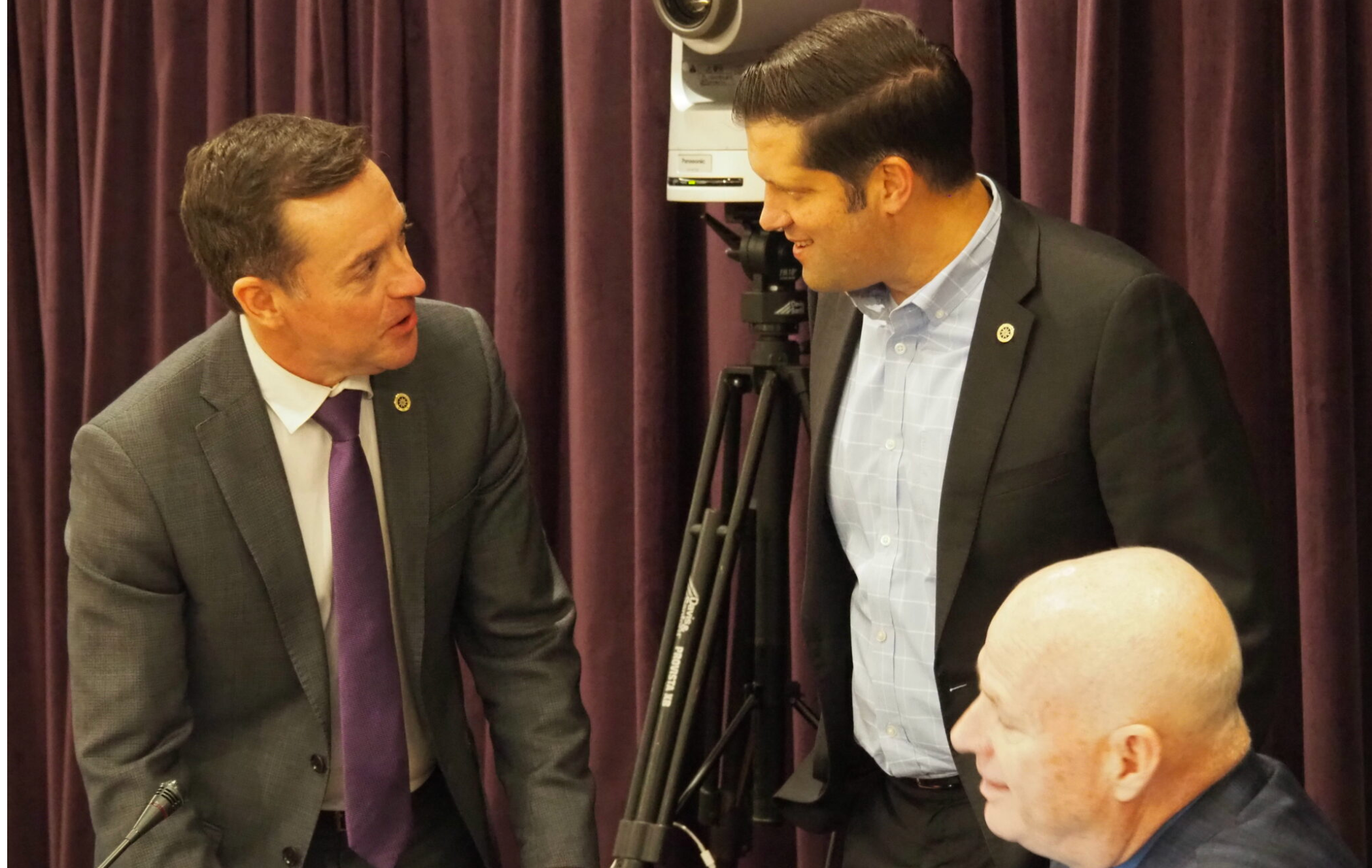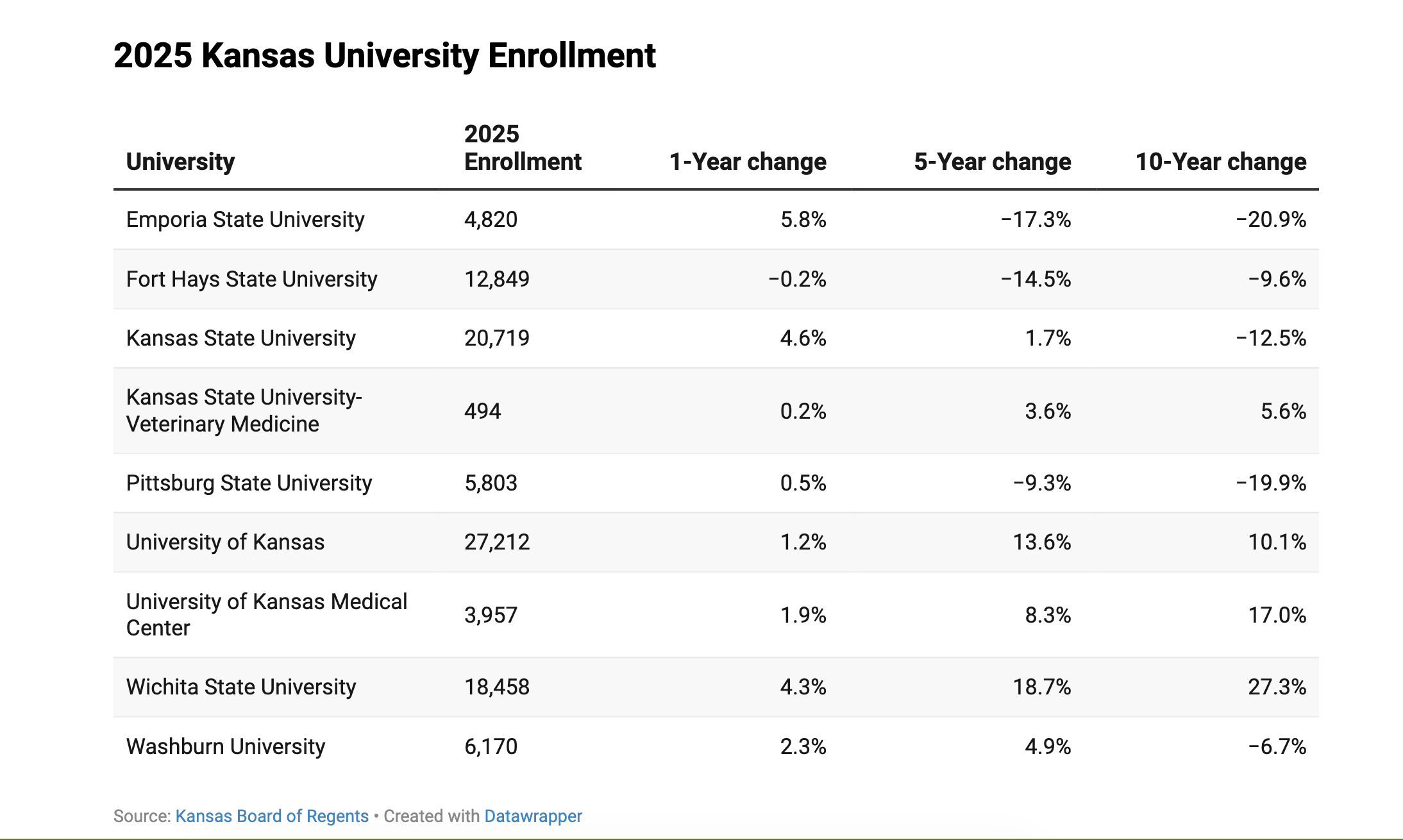
BY MORGAN CHILSON
Kansas Reflector
TOPEKA — University officials across Kansas celebrated a third year of growing enrollments on Wednesday, even though the future will present more challenges.
“We’re obviously extremely pleased,” said Blake Benson, chairman of the Kansas Board of Regents. “It’s a third consecutive year of growth, and we’re really glad to see that it’s spread out — the public universities, community colleges and technical colleges are all up, so very, very positive news.”
In general, Board of Regents public universities saw enrollment growth or stayed level. The only drop was at Fort Hays State University, which essentially stabilized with a decrease of 0.2%. Washburn University increased enrollment by 2.3%.
Twelve of 19 Kansas community colleges also posted enrollment growth, although Fort Scott Community College seeing a decreased enrollment of 17.2%, Kansas Board of Regent data showed. All six technical colleges Increased or stayed stable in their enrollment.
Emporia State University saw the biggest enrollment jump this year of 5.8%, a strong recovery after posting losses since 2020. The school increased enrollment by 263 students, for a total of 4,820.
In a letter to students, ESU president Ken Hush attributed the growth to no tuition or fee increase for two years, increasing student scholarships awarded by 141%, investment in student activities and more funding from the ESU Foundation, among other factors.
The university fired tenured faculty as part of restructuring efforts.
“When we began our transformation, we predicted changes in our enrollment as we took on the challenges facing our university, with the prediction for fall 2025 holding stable after some initial decreases,” Hush wrote, adding he was pleased to instead post a 6% increase.

Kansas State and Wichita State increased enrollment at about the same rate, 4.6% and 4.3%, respectively. The University of Kansas posted a 1.2% increase, while the University of Kansas Medical Center enrollment increased 1.9%.
“We’ve been working diligently on a strategic enrollment plan, and we’re really seeing the fruits of the labor across campus and have had some of the largest enrollment gains that we’ve seen,” said Karen Goos, K-State’s vice provost for enrollment management.
Freshmen enrollment numbers were up 7.5% this year, she said. Growth is occurring with both new students and retention of current students, Goos added.
Scott Cason, Fort Hays State University spokesman, said the school’s on-campus enrollment increased by 2% this year and the number of new undergraduate students attending the school grew by 9%.
“Our residence halls are in full capacity right now,” he said. “We haven’t seen that in a long time. It shows you that the on-campus experience is still a draw, even in times where there have been increasing questions about the perception of the value of the college degree.”
The school did see a small decrease in international students and in general in online enrollment, Cason said. Once dominating among Kansas schools in online enrollment, FHSU has more competition in that arena and experienced a drop after the COVID-19 pandemic.
Other schools are reporting decreasing numbers of international students, but that data won’t be collected by the Board of Regents until later in the school year, Benson said.
Cason said Fort Hays State lost only three international students. He attributed that to their diversity of enrollment sources internationally.
“We’re actually up in our early college program that includes our international students. We have partner campuses,” he said, adding that although they have strong partnerships in China, they also draw from Bolivia, Brazil, Cambodia and Senegal.
“We haven’t seen the disruption that other schools have seen that count more heavily on traditional international student models,” he said.
Challenges are expected for post-secondary institutions in coming years as the number of students graduating from Kansas high schools will begin decreasing next year. The change is often referred to as an enrollment cliff. In addition, schools are already experiencing decreases in graduating high school students who enroll in higher education, she said.
“What we’re seeing is the percent of students who are having any post-secondary credentials after high school has declined pretty significantly,” Goos said. “We actually have seen an increase of high school graduates. This will be the last year. After this, we will start to decline.”
Benson said the decrease in number of graduating high school students in 2026 is one of the primary challenges facing higher education.
“That’s probably not going to be just a two- or three-year challenge,” he said. “That’s going to be that way for the foreseeable future. That just means the pool of traditional college-age students will continue shrinking, even as the demand for college-educated workers keeps growing.”
That makes it imperative for Kansas to increase the number of students going to college to meet workforce needs, Benson said.
“I think we’ve also got to work to enroll adult learners, including those who may already have some college credit but no degree,” Benson said. “I don’t think that there’s going to be a silver bullet answer to it, but I’m really proud of the steps that the system in our institutions have taken to get ready for those challenges, and I think that we’ll be able to meet them.”
K-State is planning for all those challenges, Goos said.
“We’re just launching a new strategic enrollment plan with the idea of thinking about, how do we move forward with the enrollment cliff?” she said. “How do we position ourselves?”








